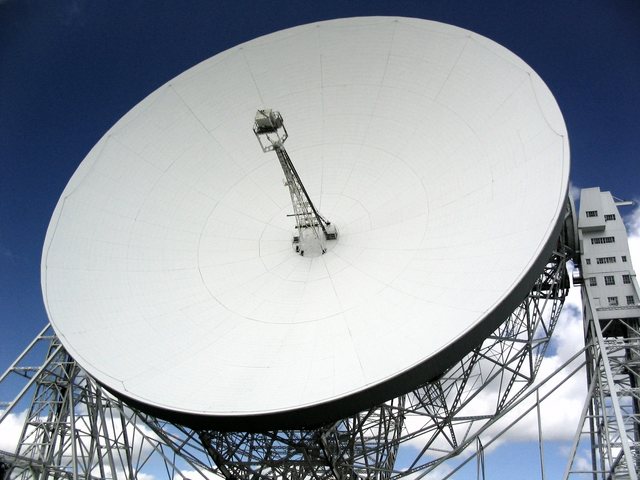
The Lovell Telescope at Jodrell Bank Observatory which provided valuable radio data for the Fermi observations (credit: Anthony Holloway, University of Manchester).
More images of the Lovell Telescope can be found in our image gallery.
For other mages related to this press release please visit NASA's GLAST news
Lovell helps scientists solve gamma-ray mystery
2 July 2009
Many of the most rapidly rotating objects in the universe, called millisecond pulsars, have been detected in gamma-rays for the first time by the Fermi satellite. These detections of extremely high energy photons were only possible thanks to the contributions of radio telescopes like the University of Manchester's Lovell Telescope at Jodrell Bank.
Scientists from the University of Manchester have worked with an international team of astronomers using NASA's Fermi Gamma-ray Space Telescope to get a new look at the spinning cosmic lighthouses known as pulsars. In two studies to be published in the July 2 edition of Science Express, the team has analyzed gamma-rays from two dozen pulsars - including eight of the most rapidly rotating pulsars.
A pulsar is the rapidly spinning and highly magnetized core left behind when a massive star explodes. Most of the 1,800 catalogued pulsars were found through their periodic radio emissions. Astronomers believe these pulses are caused by narrow, lighthouse-like radio beams emanating from the pulsar's magnetic poles. In the largest and longest running project of its type the arrival times of the pulses of more than a third of all known pulsars are monitored on a regular basis with the Lovell telescope of the University of Manchester at the Jodrell Bank Centre for Astrophysics. This has proved to be essential for the studies presented now in Science Express.
As well as emitting at radio wavelengths it was known that a handful of pulsars also emit gamma-rays. However they are extremely faint. Even with the greatly increased sensitivity of the new Fermi Large Area Telescope (LAT), astronomers only see about one gamma-ray photon every two minutes from the brightest gamma-ray emitting pulsar, the Vela pulsar. "That's about one photon for every thousand Vela rotations," said Marcus Ziegler at the University of California, Santa Cruz, a member of the team reporting on the new pulsars. "From the faintest pulsar we studied, we see only two gamma-ray photons a day."
Like spinning tops, pulsars slow down as they lose energy. Eventually, they spin too slowly to power their characteristic emissions and become undetectable. But pair an old, retired pulsar with a normal star, and a stream of stellar matter from the companion can spill onto the pulsar and spin it up. Rotating between 100 and 1,000 times a second, ancient pulsars can be revitalised and resume the activity of their youth.
The extreme faintness of the gamma-ray emission from these so-called reborn pulsars means that in order to correctly add up the signal in line with their extreme rotation periods, accurate models of how they rotate are needed. "It is only dedicated monitoring observations with telescopes like the Lovell that make it possible to see these remarkable objects in gamma-rays" said The University of Manchester's Andrew Lyne. "Despite their vastly different rotation rates, ages and magnetic field strengths it seems that these reborn pulsars and the normal pulsars share something in the way they emit gamma-rays" said Ben Stappers also of the University of Manchester.
The radio beam carries only a tiny fraction, a few parts per million, of the total power emitted by a pulsar, whereas its gamma rays can account for around 10 percent of the energy budget. In order to do so, pulsars must be able to accelerate particles to speeds near that of light. These particles emit a broad beam of gamma rays as they arc along curved magnetic field lines. Discovering the previously unseen faint emission of these broad beams, allowed the new pulsars to be discovered as part of a comprehensive search for periodic gamma-ray fluctuations using five months of Fermi LAT data and new computational techniques.
"Before launch, some predicted that Fermi might uncover only a handful of new pulsars during its mission," Ziegler added. "To discover 16 in its first five months of operation is really beyond our wildest dreams."
"Fermi has truly unprecedented power for discovering and studying gamma-ray pulsars," said Paul Ray of the Naval Research Laboratory in Washington. "Since the demise of the Compton Gamma Ray Observatory a decade ago, we've wondered about the nature of unidentified gamma-ray sources it detected in our galaxy. These studies from Fermi lift the veil on many of them."
NASA's Fermi Gamma-ray Space Telescope is an astrophysics and particle physics partnership, developed in collaboration with the U.S. Department of Energy, along with important contributions from academic institutions and partners in France, Germany, Italy, Japan, Sweden, and the U.S.
For more information please contact Alex Waddington, Media Relations Officer, The University of Manchester, 0161 275 8387 / 07717 881569.
For Images related to this press release please visit
http://www.nasa.gov/mission_pages/GLAST/news/
The UK Science and Technology Facilities Council (STFC) support the pulsar work with the Lovell Telescope through a rolling grant.


